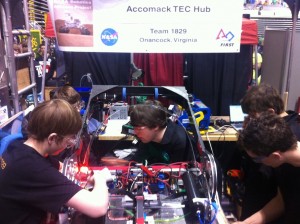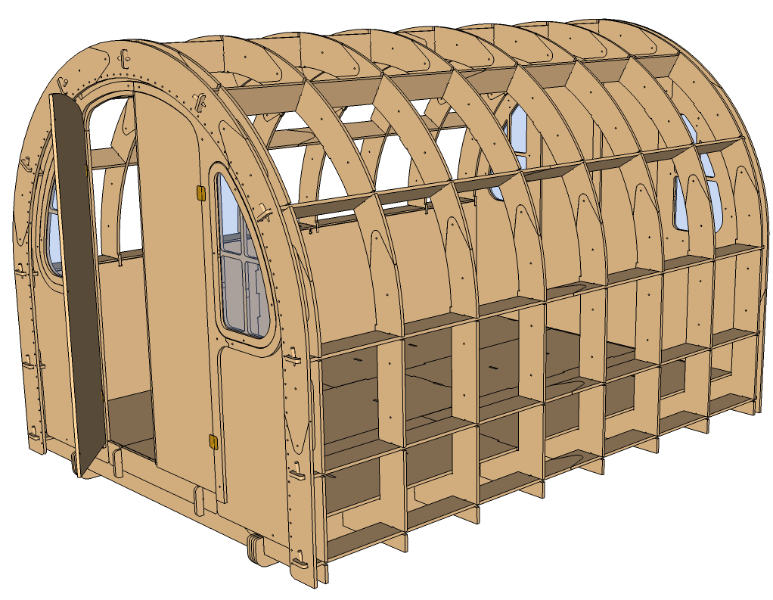 In 2003, the director of technical education at the Clark County School System in Las Vegas, NV took a big step: CNC (computer numerically controlled) equipment was introduced into the woodworking programs at most of the middle schools and high schools in the district. It was a bold step, one taken to introduce technology (computers) into what was seen as a vocational arena (woodworking). Included in the purchase of the initial group of ShopBots (funded in part with Perkins grants) were several days of training for the teachers who would be using and teaching with the new equipment. As with any new program that is introduced from the top down, some of the woodworking instructors saw the new technology as a gift with which to inspire and motivate their students. Others saw it as an expensive new storage table.
In 2003, the director of technical education at the Clark County School System in Las Vegas, NV took a big step: CNC (computer numerically controlled) equipment was introduced into the woodworking programs at most of the middle schools and high schools in the district. It was a bold step, one taken to introduce technology (computers) into what was seen as a vocational arena (woodworking). Included in the purchase of the initial group of ShopBots (funded in part with Perkins grants) were several days of training for the teachers who would be using and teaching with the new equipment. As with any new program that is introduced from the top down, some of the woodworking instructors saw the new technology as a gift with which to inspire and motivate their students. Others saw it as an expensive new storage table.
An article in the April/May 2010 issue of American Woodworker followed up on the some of the Clark County School’s shops using ShopBot CNC machines 8 years after implementation. The focus of the article was on woodworking, but a quote from one of the students points out that CNC technology has a bigger impact than making a bookshelf, “Wow, that X, Y, Z axis stuff really does have an application. I get it now.” One teacher encourages his experienced students to work outside the classroom to create projects that benefit the school or community. In one example, several students used CAD/CAM software and their ShopBot to create donation collection boxes for a Relay for Life event.
Design Thinking, problem-based learning (PBL), and STEM (Science, Technology, Engineering and Math) education are all about recognizing a need (stating a problem), creating a solution, prototyping, testing, redesigning, making use of life skills that include working in groups, and documenting the work. At ShopBot, we see that some teachers who started in woodworking are taking the initiative to use CNC equipment to expand the capabilities of their students into what could be categorized as STEM fields. To quote Matt McGuire from Elwood Middle School in NY “I have already started pulling the program from the traditional “shop” class by incorporating basic electronics, renewable energies, hydroponics, and flight. I was able to talk with the head of the district’s technology about getting approximately 10 computers into my room and the many different paths we could go with it, from this digital fabrication to robotics, and he seemed very interested in supporting this idea.” Matt applied for, and received, a grant from Toshiba to purchase his ShopBot CNC.
Educators using one of the organized programs that starts with a STEM curriculum such as Project Lead the Way may use CNC equipment to make real the projects rendered on screen using the 3D engineering software, Inventor. Competitions related to robotics such as First Robotics can also utilize CNC to manufacture parts for robots, or even to machine circuit boards. Students participating in SkillsUSA may be more competitive using CNC technology. 
While important, the nature of these programs limits the number of people who can take part to a select few. The philosophy of the FabLab network is to make available to all people the tools and technology to make what is relevant to their interests and environment. In a presentation at the FabLearn conference in 2012, Paulo Blikstein suggested that the simple act of making can do wonders for students self-efficacy, even if the projects don’t seem to be geared towards engineering and science. With Project-Based Learning, many underlying concepts, skills, and processes are introduced in the context of an entire project rather than as separate subjects which then might be integrated and applied. When folks are working on a project that is of interest/relevance to them, the knowledge that they are acquiring has a framework to fit into, and students are willing to work harder when they can see the purpose of their studies.
Over the course of several blogs, I intend to focus on areas of interest that use CNC equipment as one of the tools in their digital fabrication toolboxes. Many will be related to STEM topics, and some more related to art. Today, let’s talk food production and sustainability. A type of agriculture, termed “permaculture” by Bill Mollison and David Holmgren in the 1970’s, is based on three fundamental values — care for the Earth, care for people, and return of surplus. It’s farming that works with nature, with the intentions of eliminating waste and decreasing the amount of external additives like pesticides and herbicides. It’s also a model for thinking about systems. In an interview in November, 2013, Blair Evans of Incite Focus FabLab describes how creating an urban garden in Detroit can lead to bigger things. “Permaculture,” Blair says, “is based in systems thinking. But it’s hard to understand systems in general unless you understand one system well that you can abstract from. Unfortunately, in communities that are disenfranchised or under-resourced, there aren’t a whole lot of opportunities to get experience with well-functioning systems. Everybody can get some tomato plants and some worms and some soil, though, and have an extraordinarily complex system to work with and then scale up from.” 
 While digital fabrication tools may not seem to mesh with creating a garden, Blair believes that, with their help, people are capable of producing most of the things they need, including shelter and food. One of the projects that the Incite Focus produces with its ShopBot CNC is a shelter/green house based on the Shelter 2.0 design of Robert Bridges and Bill Young.
While digital fabrication tools may not seem to mesh with creating a garden, Blair believes that, with their help, people are capable of producing most of the things they need, including shelter and food. One of the projects that the Incite Focus produces with its ShopBot CNC is a shelter/green house based on the Shelter 2.0 design of Robert Bridges and Bill Young.
Part of the system includes the insects that pollinate our plants. In recent years, the population of bees has been under stress. At least two FabLabs are engaged working to help the bees.  The green FabLab Valldaura, above Barcelona, is manufacturing smart hives to monitor the health of bees. Watch the video to see how the big parts are cut with a ShopBot for the precise fit and ease of assembly, other parts are laser-etched, and electronics/sensors are included to monitor the temperature and activity of the hives. Another fun and informative video is available from Open Source Beehives. It is a project that includes CAD/CAM design, good woodworking and finishing skills for making the hives, a knowledge of nature to account for the health and happiness of the bees, and videography and stop action techniques to create the video.
The green FabLab Valldaura, above Barcelona, is manufacturing smart hives to monitor the health of bees. Watch the video to see how the big parts are cut with a ShopBot for the precise fit and ease of assembly, other parts are laser-etched, and electronics/sensors are included to monitor the temperature and activity of the hives. Another fun and informative video is available from Open Source Beehives. It is a project that includes CAD/CAM design, good woodworking and finishing skills for making the hives, a knowledge of nature to account for the health and happiness of the bees, and videography and stop action techniques to create the video.
Another side of sustainability is to re-use and re-purpose what was considered waste. Not everyone can afford to put in place a recycling center like that found at Charlotte-Douglas airport, which includes a large worm farm to turn food waste into compost. But at the Maker Faire in Paris in 2014, I saw an example of a personal composting station which included a space for growing herbs or flowers at the top. Kitchen waste goes into the top drawer, and the material drops down through screens with finer and finer mesh as it composts. Fab Lab Wgtn at Massey University, New Zealand recognized that CNC manufacturing itself creates a large amount of sawdust as waste. Wendy Neale and Jason Mitchell reported at the Fab10 conference in Barcelona (2014) that they composted food waste and other biodegradables from around campus with clean wood dust from their ShopBot in tumbling worm farms composting bins. It took a commitment from the community of ShopBot users to keep separate the clean wood that went into the central dust collection system, and the other materials that were vacuumed up separately. After an analysis of the compost, it was deemed free of heavy metals and toxins, and safe for use in the gardens. When you consider that their partner, the Kuratini Marae cultural center, produces about a ton of food waste each year, and the ShopBot produces 500- 800 kilos of wood dust, composting the food waste, garden waste, and sawdust removes a significant burden on the land fill, as well as reducing the need to purchase compost for the University gardens.
Fab Lab Wgtn at Massey University, New Zealand recognized that CNC manufacturing itself creates a large amount of sawdust as waste. Wendy Neale and Jason Mitchell reported at the Fab10 conference in Barcelona (2014) that they composted food waste and other biodegradables from around campus with clean wood dust from their ShopBot in tumbling worm farms composting bins. It took a commitment from the community of ShopBot users to keep separate the clean wood that went into the central dust collection system, and the other materials that were vacuumed up separately. After an analysis of the compost, it was deemed free of heavy metals and toxins, and safe for use in the gardens. When you consider that their partner, the Kuratini Marae cultural center, produces about a ton of food waste each year, and the ShopBot produces 500- 800 kilos of wood dust, composting the food waste, garden waste, and sawdust removes a significant burden on the land fill, as well as reducing the need to purchase compost for the University gardens. 
To return to Clark County, Nevada, let’s take a look at the areas in their CTE (Career and Technical Education) brochures that could benefit from the use of CNC equipment. I will further explore some of those areas in future blogs. And we haven’t even begun to explore the world of art.
Furniture and Cabinet making Agriculture, Food, Natural Resources Theater Design Technology Mechanical Drafting & Design Renewable Energy Technology PLTW engineering design, 3D design